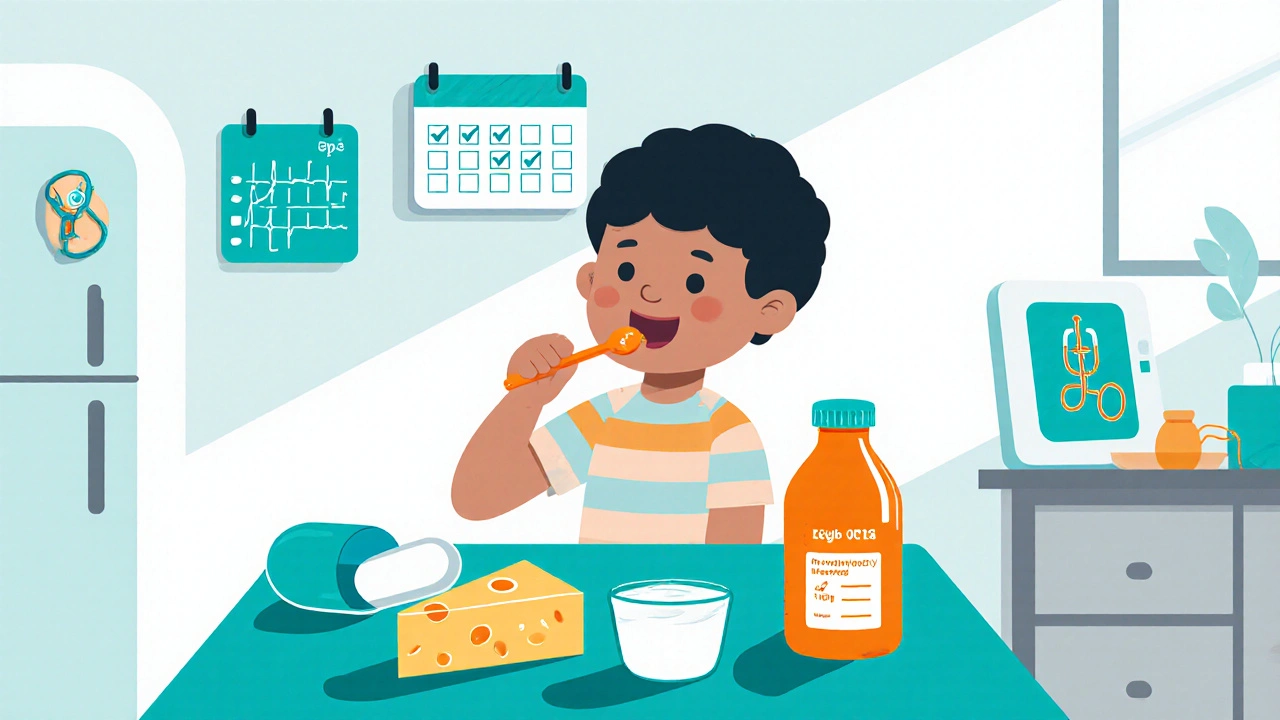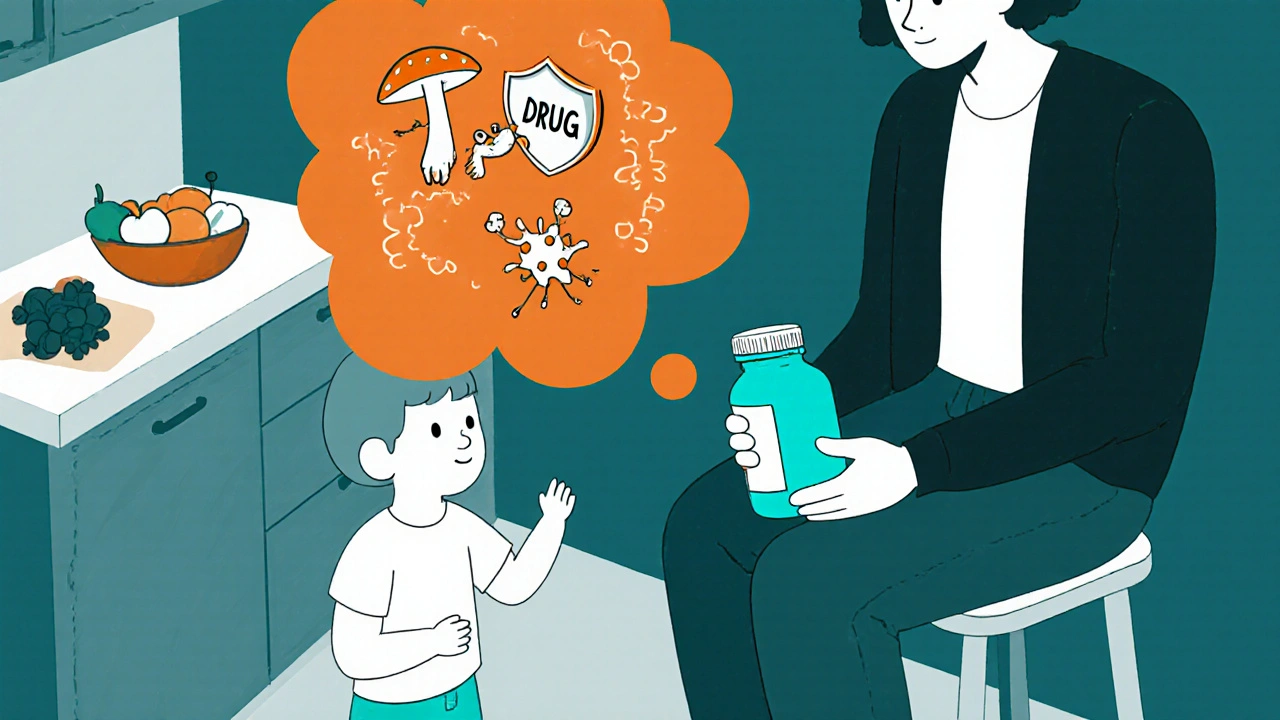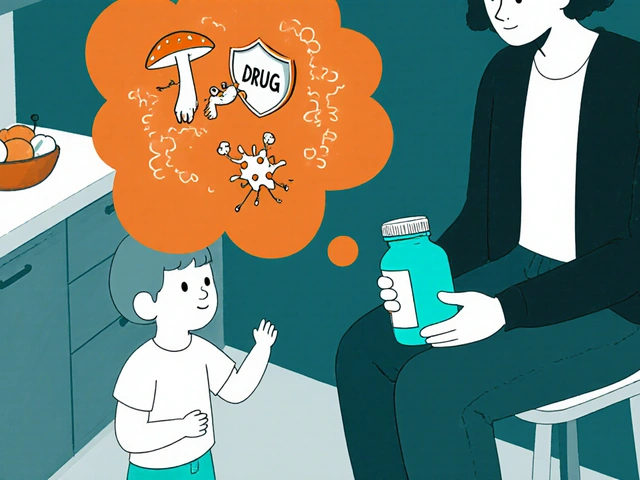Itraconazole Pediatric Dosage Calculator
Dosage Calculator
Calculate the correct itraconazole dosage for children based on weight. Follows guidelines from Pediatric Infectious Diseases Society (2024).
When a kid is battling a stubborn fungal infection, the first question parents ask is: "Is this medicine safe for my child?" The answer hinges on the right drug, the right dose, and the right monitoring plan. Below you’ll find everything you need to know about using itraconazole in children, from how it works to exact dosage tables and safety checkpoints.
What is Itraconazole an oral antifungal medication that blocks the growth of a wide range of fungi by inhibiting the enzyme lanosterol 14α‑demethylase?
Itraconazole belongs to the triazole family. By disrupting the fungal cell membrane, it stops the pathogen from reproducing. It’s absorbed well when taken with food, and the drug stays in the body long enough to treat deep‑seated infections such as onychomycosis (nail fungus) or invasive candidiasis.
When is itraconazole prescribed for Children individuals under 18 years of age, whose dosing must be calculated by weight or body surface area?
Doctors reserve itraconazole for infections that either don’t respond to first‑line agents or need a drug that reaches hard‑to‑penetrate sites. Typical pediatric indications include:
- Invasive candidiasis
- Blastomycosis
- Histoplasmosis
- Severe dermatophyte infections (e.g., Dermatophyte a fungus that feeds on keratin in skin, hair, or nails)
Because the drug can affect liver enzymes, it’s not a first‑choice for simple superficial infections unless the child can’t tolerate alternatives.
Exact dosage guidelines - how to calculate the right amount
Dosage for kids is weight‑based. The most trusted reference (Pediatric Infectious Diseases Society, 2024) recommends:
- Determine the child’s weight in kilograms.
- Apply the dose range of 5-10mg/kg/day, divided into two doses.
- Do not exceed the adult maximum of 400mg/day.
Below is a quick‑look table that converts weight ranges into practical capsule or suspension amounts.
| Weight (kg) | Daily Dose (mg) | Formulation | Number of Doses per Day |
|---|---|---|---|
| 10-15 | 50-75 | Liquid (100mg/5ml) | 2 (25-37.5mg each) |
| 16-25 | 80-125 | Capsule 100mg | 2 (40-62.5mg each) |
| 26-35 | 130-175 | Capsule 100mg | 2 (65-87.5mg each) |
| 36-45 | 180-225 | Capsule 100mg | 2 (90-112.5mg each) |
| 46-55 | 230-275 | Capsule 100mg | 2 (115-137.5mg each) |
For children who need the higher end of the range (10mg/kg/day), watch the total daily dose closely to stay under 400mg.
Adjusting the dose for liver concerns - the role of Liver function test blood analyses that measure enzymes like ALT, AST, and bilirubin to assess hepatic health
Itraconazole is metabolized by the liver. If a child has pre‑existing liver disease or elevated enzymes, start at the lower 5mg/kg/day limit and repeat liver function tests after one week, then monthly. If ALT or AST rise more than three times the upper limit of normal, consider reducing the dose by 25% or switching to an alternative.
Monitoring and safety checkpoints
Beyond liver labs, a few other checks keep the treatment safe:
- Baseline ECG: Itraconazole can prolong the QT interval, especially in children taking other QT‑prolonging drugs.
- Serum drug level (trough) after 7‑10 days: target 0.5-1.0µg/mL for most infections.
- Kidney function: not directly affected, but ensure hydration if the child is on concurrent nephrotoxic agents.
Re‑check labs at weeks 2, 4, and then every 3months for long‑term therapy.
Typical side effects you might see
Most kids tolerate itraconazole well, but be aware of these common reactions:
- Gastrointestinal upset - nausea, abdominal pain, or diarrhoea.
- Skin rash or mild itching.
- Headache.
Serious events such as severe liver injury, allergic reactions, or heart failure are rare but require immediate medical attention.
Drug interactions - what the CYP3A4 enzyme a liver enzyme that metabolizes many medications, including itraconazole can cause
Itraconazole is a strong inhibitor of CYP3A4. It can raise levels of drugs such as:
- Statins (e.g., simvastatin) - risk of muscle toxicity.
- Calcium channel blockers - may cause low blood pressure.
- Immunosuppressants (cyclosporine, tacrolimus) - need dose adjustments.
Always give the prescribing doctor a full medication list, including over‑the‑counter supplements like St.John’s wort, which can dramatically lower itraconazole concentrations.

Alternatives - when to consider Fluconazole another oral triazole with a more favorable safety profile in children, especially for Candida infections or Terbinafine an allylamine antifungal used mainly for dermatophyte nail infections
If a child cannot tolerate itraconazole or has significant liver enzyme elevations, look to these options. The table below helps compare the main pediatric traits.
| Antifungal | Typical Pediatric Dose | Treatment Duration | Main Advantage | Notable Risk |
|---|---|---|---|---|
| Itraconazole | 5-10mg/kg/day | 2-12weeks | Broad spectrum, good nail penetration | Hepatotoxicity, CYP3A4 interactions |
| Fluconazole | 6-12mg/kg/day | 2-6weeks | Lower liver impact, fewer drug interactions | Limited activity against some molds |
| Terbinafine | 10-15mg/kg/day | 6-12weeks (nail) | Excellent for dermatophytes, rapid nail cure | Possible taste changes, rare liver effects |
Choose the drug that best matches the infection type, child’s liver status, and any other medicines they’re taking.
Practical tips for parents - getting the most out of therapy
- Give the medication with a fatty snack (milk, cheese, or a full‑fat yogurt) to boost absorption.
- Use a calibrated oral syringe for the liquid form; a small dosing error can change the daily total.
- If a dose is missed, give it as soon as remembered unless it’s less than 8hours later - then skip and resume the regular schedule.
- Keep a medication diary noting the dose, time, and any side effects. This helps the doctor spot trends early.
- Store capsules in a cool, dry place; the suspension should be refrigerated and discarded after 14days once opened.
Following these steps reduces the chance of sub‑therapeutic levels and keeps the treatment on track.
Key takeaways
- Itraconazole dosage for children is weight‑based (5-10mg/kg/day) split into two doses.
- Baseline and periodic liver function tests are mandatory.
- Watch for drug interactions, especially with CYP3A4 substrates.
- Common side effects are mild, but severe liver injury requires immediate stop.
- Alternatives like fluconazole or terbinafine may be better if liver enzymes rise.
Frequently Asked Questions
Can I give itraconazole to a toddler?
Yes, but only under a doctor's order. The dose is calculated by weight, and the child’s liver enzymes must be checked before starting and during treatment.
How long does treatment usually last?
Duration depends on the infection type. Skin and nail infections can require 8‑12weeks, while invasive candidiasis may be cleared in 2‑4weeks with close monitoring.
What should I do if my child develops a rash?
A mild rash is often harmless, but contact the physician promptly. If the rash spreads, causes swelling, or is accompanied by fever, stop the drug and seek emergency care.
Are there food restrictions while taking itraconazole?
Take itraconazole with a fatty meal or snack to improve absorption. Avoid grapefruit juice, as it can increase drug levels and raise the risk of side effects.
Do I need to check my child’s heart rhythm?
A baseline ECG is recommended, especially if the child is on other QT‑prolonging medications. Repeat the ECG if any palpitations, dizziness, or fainting occur.



Alexis Howard
October 17, 2025 at 12:17I don't see why anyone makes a big deal out of itraconazole dosing.
Darryl Gates
October 23, 2025 at 05:07Hey, dosing kids on itraconazole isn’t rocket science if you follow the weight‑based chart. Make sure you split the total daily dose into two equal parts and give it with a fatty snack for better absorption. Keep a close eye on liver labs – a baseline and then every few weeks is key. If you notice any rash or stomach upset, call the pediatrician right away.
Kevin Adams
October 28, 2025 at 20:56Behold, the saga of a child’s battle against invisible invaders! The humble itraconazole, a silent sentinel, weaves its spell within the fungal citadel. Yet the universe demands balance – the child’s weight becomes the compass, the dose the map. Each milligram is a promise, each capsule a covenant between healer and the tiny warrior. When the liver, that ancient alchemist, whispers warnings, we must heed and adjust. A rise in ALT is not mere noise; it is the drumbeat of a hidden rebellion within cells. The ECG, a silent scroll, may reveal the clandestine prolongation of QT, a secret known only to the heart’s scribes. Do not ignore the serum trough levels after ten days; they are the true oracle of efficacy. Remember, the drug’s path is paved with fat – a cheese‑laden snack can turn the tide. And if the rash spreads like a flag of defiance, cease the ritual and summon the physician. The world of CYP3A4 is a tangled web, a conspiratorial network of enzymes that can turn allies into foes. Statins, calcium channel blockers, immunosuppressants – they all feel the tremor of itraconazole’s might. In the face of such complexity, the caregiver becomes the philosopher‑king, balancing risk and reward. Let the medication diary be your chronicle, a testament for future generations. And should the child’s spirit falter, know that alternatives await – fluconazole with its gentler touch, terbinafine with its nail‑deep resolve. Yet the choice remains yours, guided by labs, symptoms, and the inexorable march of time. So arm yourself with knowledge, hold the dosage chart close, and march onward into the fungal frontier.
Katie Henry
November 3, 2025 at 13:46Esteemed caregivers, may I extend my utmost encouragement as you navigate this therapeutic voyage. It is imperative that each administered dose adheres precisely to the weight‑based schema, thereby safeguarding hepatic integrity. I commend your diligence in scheduling periodic liver function assessments, for they constitute the cornerstone of patient safety. Should any adverse manifestation arise, promptly engage the attending pediatric specialist. Let us collectively aspire to optimal outcomes through vigilant monitoring and steadfast adherence.
Joanna Mensch
November 9, 2025 at 06:36Ever wonder why the big pharma pushes itraconazole so hard? They say it’s life‑saving, but the hidden side‑effects are kept quiet. Every time you order a liver panel, think about who profits from the extra lab work. The real cure might be something natural, yet the industry silences those voices. Stay wary, keep your eyes open, and don’t let them dictate your child’s health.
Nickolas Mark Ewald
November 14, 2025 at 23:26That makes sense. Simple steps like using a syringe and writing down doses really help keep everything clear.
Chris Beck
November 20, 2025 at 16:15Our doctors know best when it comes to using itraconazole here in the US we trust the guidelines!
Sara Werb
November 26, 2025 at 09:05OMG!!! iTtraconazole is like the secret weapon!!! but the media won’t tell u the truth!!! they hide the side effects like!!! they want u to keep buying!!!
Winston Bar
December 2, 2025 at 01:55Honestly, the whole hype around dosing charts feels overblown. Kids can handle a little variation, and the labs are just a hassle. If they get a rash, you just stop and move on – no need for endless monitoring.
Russell Abelido
December 7, 2025 at 18:45I get where you’re coming from, but seeing a child in discomfort tugs at the heart. 🙂 Remember, the liver tests are there to protect, not punish. We all want the best outcome, and a little patience goes a long way.
Steve Holmes
December 13, 2025 at 11:34It’s fascinating how weight‑based dosing turns a complex treatment into something manageable! The tables provide a clear roadmap for parents, and the extra labs act like checkpoints on a journey.